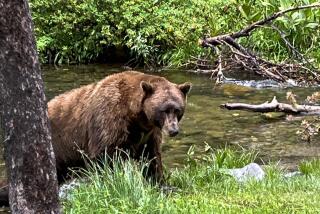Obama administration proposes a critical habitat in Alaska for polar bears
SEATTLE — In what would be the largest habitat zone ever established in the U.S. to protect a species from extinction, the federal government on Thursday proposed designating 200,541 square miles on the coast of Alaska as critical habitat for polar bears.
Officials said the designation was not likely to further slow the pace of oil and gas development, and it would not impose any controls to slow the biggest threat to polar bears: the melting of sea ice as a result of climate change.
Those steps are crucial for polar bears but are being addressed separately in Congress through proposals to cap greenhouse gas emissions, said Tom Strickland, assistant Interior secretary for fish, wildlife and parks.
“We recognize that the greatest threat to the polar bear is the melting of sea ice. We also recognize that the Endangered Species Act is not the tool to directly address carbon emissions, which are the root cause of climate change,” Strickland told reporters in a conference call from Washington.
The critical habitat, proposed after conservationists filed suit demanding it, follows warnings that the polar bear could disappear from U.S. waters within the next century.
The melting of sea ice has left the bears with a dramatic reduction in the ice floes they need for breeding, resting and hunting for seals and other food.
Increasingly, bears have been driven to land, where food is harder to come by and conflicts with residents of native villages of Alaska’s North Slope, who are legally entitled to hunt polar bears for subsistence, have become more common.
The proposed critical habitat covers three distinct areas along the northern and northwestern coasts of Alaska: the coastal barrier islands and spits along the coast; sea ice over the continental shelf in waters less than 980 feet deep; and terrestrial denning habitat from five miles to about 20 miles inland.
Conservationists have warned that proposals for major new offshore oil and gas development in the Beaufort and Chukchi seas could impair efforts to protect the bear. Although the proposed habitat designation includes most of the current and planned energy development zones, Strickland said new oil and gas activities already were being scrutinized after polar bears were listed as a threatened species in May 2008.
Strickland said the proposed designation would provide “added emphasis to the plight of the bear.”
He added, “We do not believe that it will be a significant additional burden upon the industry.”
Conservation groups said the habitat designation was a step forward, but it did not achieve significant strides to protect the bear without addressing the major threats to the species.
“They can say that all they want, but they can’t change the plain language of the [Endangered Species Act]. The law says federal agencies cannot ‘adversely modify’ critical habitat. Hard to see how putting an oil rig in the heart of polar bear habitat does not adversely modify it,” said Brendan Cummings, senior attorney with the Center for Biological Diversity, which is one of several groups suing to win heightened protections for the bears.
“As for climate change, again, how do approvals of large-scale projects that will contribute substantial greenhouse emissions not contribute to the ultimate loss of sea ice?” he said.
Andrew Wetzler, wildlife conservation project director at the Natural Resources Defense Council, said federal officials now would have to consider the effects of new drilling activity not just on existing polar dens, but also on places in the habitat area that might be used as a den, even if no polar bears are there.
Alaskan officials this week stepped up their legal fight to cancel the Endangered Species Act designation, filing two new legal briefs in a federal court case pending in Washington that ultimately could decide some of the larger questions over greenhouse gas emissions, oil and gas development, and protection of the sea ice.
“There are two competing visions of the future of Alaska,” state Atty. Gen. Dan Sullivan said in a statement. “Ours is one in which responsible resource development proceeds apace and protections remain in place for wildlife, including polar bears, which we treasure. The other vision is one in which Alaska’s resources are locked up, our economy languishes, we lose population and we lack the capacity to maintain schools, roads, bridges, harbors and airports, or to provide for public safety.”
The state’s motion argues that scientific predictions of a decline in sea ice, and the probable effects of climate change on bear populations, are too uncertain to support listing the bears under the Endangered Species Act.
About 1,500 bears are believed to reside in the southern Beaufort Sea. The Chukchi Sea population hasn’t been comprehensively counted since 20 years ago, when it numbered about 2,000.
Cindy Shogan of the Alaskan Wilderness League said the critical habitat designation should set the stage for a “timeout” on all major new development until its effect on polar bears can be assessed.
“Today’s announcement . . . acknowledges that some of the most sensitive areas on land and in the offshore waters of America’s Arctic -- including much of the coastal plain of the Arctic National Wildlife Refuge -- are key to the species’ survival,” she said.
--
More to Read
Sign up for Essential California
The most important California stories and recommendations in your inbox every morning.
You may occasionally receive promotional content from the Los Angeles Times.










